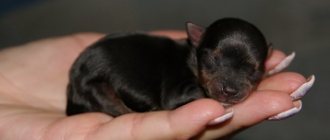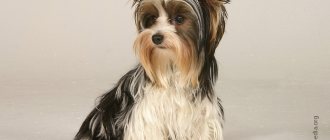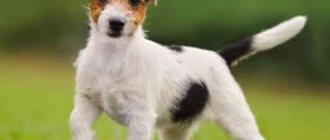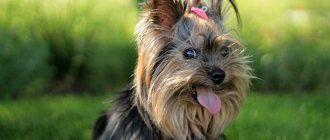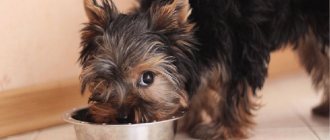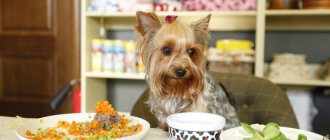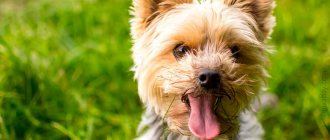The Yorkshire Terrier is one of the most beloved breeds of decorative dogs.
Yorkies' fur is constantly growing hair, but it does not cause allergies. In this regard, even people suffering from allergies to animal fur can keep a terrier at home.
By nature, this is one of the most inquisitive and charming dogs. Also a big plus is the possibility of keeping this dog even in a small apartment .
One of the problems with Yorkie girls is difficult childbirth . Dogs often require medical attention.
Advice! It is worth carefully monitoring all periods of your dog’s pregnancy with a veterinarian. And in case of problems in a dog giving birth, immediately call a doctor.
The number of puppies in a Yorkshire Terrier litter ranges from one to five, sometimes more, depending on the health of the expectant mother and the heredity of the male.
Caring for a Yorkshire Terrier puppy in the first days after birth
Yorkie puppies are born within half an hour of each other . It happens that a terrier giving birth for the first time does not understand what to do, so consult your doctor in advance about how to help the dog.
When born, Yorkshire Terrier puppies are blind, deaf and have no teeth . In addition, they are black . The weight of a newborn Yorkie puppy is approximately 70 to 125 grams .
Important! With their first breath, newborn Yorkies scream loudly; they must breathe through their nose. A few minutes later, he begins to navigate and look for his mother's nipple - this is an innate instinct. If the puppy is weak and breathes through its mouth, then you need to call a veterinarian or a breeder who has experience in giving birth to this breed.
How to care for a Yorkshire Terrier puppy? In the first days, their mother takes care of them . After the mother has licked all the puppies , examine them - their bodies should be elastic.
For several days the babies sleep and eat all the time . They have stool up to 4-5 times a day. Therefore, change diapers often in the playpen where the dog lives with newborns.
Babies should be active, crawl, look for their mother’s nipple, and at this time you don’t have to touch them - just keep an eye on them. She licks and turns them over herself.
Advice ! If puppies are crying and whining, they are probably low on milk or have a stomach ache. If the puppy's belly is swollen, give it to the dog and apply butter to the puppy's anus so that she can lick it and help the baby.
What to feed a Yorkie puppy if
there is not enough milk, then artificial supplementation is introduced .
There are specialized mixtures or you can prepare them yourself - take 400 - 500 ml of milk, one yolk and a tablespoon of dry cream .
The mixture is stirred until the dry matter is completely dissolved, heated to 35° and fed to the babies.
If a tragic situation occurs and the babies are left without a mother, then you need to urgently consult with the breeder or a veterinarian , who will clearly explain the intricacies of caring for newborns. Ideally, you need to find a nursing dog.
If this is not possible, then for the first week, feed with formula milk 12-20 times a day , constantly wipe, turn and almost never leave the baby.
How to care?
During the first weeks of life, the puppies are looked after by a bitch - she feeds them, turns them over, and constantly licks them. The breeder must only ensure that the puppies do not become hypothermic or overheated, and that the bitch does not accidentally crush them.
On the 3-5th day, they need to remove the dewclaws, if any - you need to stretch the skin on the puppy’s paw and quickly cut off the extra toe with sharp office scissors, and then cauterize the wound with potassium permanganate.
Around the 5th-6th day, you need to trim the nails so that they do not hurt each other or the belly and nipples of the bitch during feeding.
Puppies should not be bathed until they are 3 months old, but they must examine their eyes daily and wipe them with chamomile infusion or a special lotion.
At about a month, when the coat is quite long, the puppies need to have a hygienic haircut - use a special clipper to trim the hair in the groin area, near the genitals and anus. It is also necessary to free the upper third of the ears from fur so that they do not bend under its weight and acquire the vertical position required by the breed standard.
At the same age, you should begin raising puppies, accustoming them to a diaper or tray.
When the Yorkshire Terrier grows up and is vaccinated, he should be walked every day - this is necessary not only for the physical health of an active and energetic dog, but also for its socialization and the formation of a stable psyche.
After each walk, you need to thoroughly wash your paws and belly, and give your pet a full bath about once every 3 weeks.
You should also brush your dog daily to prevent its fur from getting tangled, and monitor the condition of its teeth, mouth, and ears.
What to feed a Yorkshire Terrier puppy in the first 2 months of life
Puppies open their eyes at the age of a week or one and a half, and then they begin to hear. They can lap from the age of 2-3 weeks , at which time additional food can be introduced , since the mother’s milk may not be enough, and the puppies grow very quickly.
To do this, milk porridge first introduced into the terriers' diet .
When the pet is one month old, they begin to give : lean, finely chopped beef or chicken, eggs, cottage cheese, kefir, boiled vegetables (carrots, beets), water porridge, apples, pumpkin seeds.
At 2 months old, a Yorkie can be given dry food , which must be selected by a veterinarian for this breed, as allergic reactions are possible.
Once the puppies are a month old, you can carefully trim their nails.
Advice! It is also important to maintain the temperature regime (24 - 26 degrees), not to create drafts or heat in the apartment. You need to wipe your Yorkie's eyes with a cotton swab and examine them every morning.
Further development of babies
Before the cubs begin to see, they try to take their first hesitant steps. Gradually, when the newborn is able to distinguish surrounding objects, the pet’s gait becomes confident and conscious.
The next stage of growing up is the appearance of hearing. This happens on days 14-19. After three weeks of life, teeth erupt. From this time on, the four-legged friend begins to bite the owner’s fingers and all objects around.
At 1 month, the dog develops a tail wagging reflex. From this time, the baby begins to be fed with cottage cheese or other low-fat fermented milk products.
If you know the time when newborns open their eyelids, you can notice deviations in time and consult a veterinarian. happens in different ways. The formation of the visual organs in cubs is influenced by the breed, gestation period, and living conditions. Deviations can be associated with congenital or acquired infection, care and unsanitary conditions.
The article is of a recommendatory nature. Contact a specialist!
Source
Table of Yorkie weight changes by month
If puppies are fed properly, they should gain weight every day. For the first two weeks we weigh the Yorkies every day, then once every three days.
| Newborn puppy weight (g) | 70 – 80 | 85 – 115 | 120 – 130 | 135 – 155 | |
| 1 month | 1 Week | 105 – 115 | 140 – 185 | 190 – 230 | 150 – 270 |
| 2 week | 140 – 185 | 185 – 200 | 285 – 310 | 350 — 380 | |
| 3 week | 170 – 200 | 225 – 310 | 370 – 400 | 450 – 500 | |
| 4 week | 190 – 230 | 270 – 370 | 450 – 480 | 540 – 600 | |
| 2 month | 5 week | 230 – 255 | 310 – 425 | 480 – 550 | 620 – 680 |
| week 6 | 255 – 310 | 355 – 500 | 560 – 620 | 680 – 760 | |
| week 7 | 285 – 340 | 410 – 550 | 620 – 700 | 750 – 851 | |
| 8 week | 312 — 369 | 450 – 600 | 680 – 760 | 820 – 930 | |
| 3 month | Week 9 | 340 – 425 | 500 – 650 | 730 – 820 | 900 – 990 |
| 10 week | 370 – 450 | 540 – 700 | 800 – 870 | 960 – 1070 | |
| 11 week | 390 – 480 | 590 – 765 | 870 – 960 | 1040 – 1200 | |
| 12 week | 420 – 530 | 620 – 850 | 930 – 1050 | 1160 – 1270 | |
| Week 13 | 450 – 570 | 680 – 900 | 1020 – 1130 | 1240 – 1380 | |
| 4 month | Week 14 | 480 – 620 | 730 – 960 | 1100 – 1250 | 1330 – 1470 |
| Week 15 | 540 – 650 | 800 – 1050 | 1150 – 1300 | 1450 – 1600 | |
| Week 16 | 570 – 710 | 850 – 1100 | 1270 – 1390 | 1530 – 1670 | |
| Week 17 | 600 – 730 | 870 – 1160 | 1300 – 1450 | 1600 – 1750 | |
| 5 month | Week 18 | 620 – 800 | 930 – 1220 | 1350 – 1530 | 1700 – 1850 |
| Week 19 | 650 – 820 | 960 – 1250 | 1400 – 1600 | 1750 – 1900 | |
| Week 20 | 680 – 850 | 990 – 1300 | 1450 – 1650 | 1800 – 2000 | |
| 21 weeks | 700 – 880 | 1000 – 1350 | 1530 – 1700 | 1870 – 2050 | |
| 6 month | Week 22 | 710 — 900 | 1050 — 1400 | 1580 – 1750 | 1930 – 2100 |
| Week 23 | 740 – 930 | 1070 – 1400 | 1600 – 1800 | 1980 – 2200 | |
| Week 24 | 740 — 950 | 1100 – 1450 | 1650 – 1850 | 2000 – 2200 | |
| Week 25 | 760 – 950 | 1100 — 1480 | 1660 – 1870 | 2040 – 2240 | |
| Week 26 | 760 – 970 | 1100 – 1500 | 1700 – 1900 | 2070 – 2300 | |
| 1 year 6 months | 900 — 1200 | 1350 — 1800 | 2040 – 2300 | 2400 – 2800 | |
The numbers given in the tables are approximate and are given as a guide for the owner to understand that the Yorkie puppy is being fed correctly and is not overfed, or worse, is he underweight.
Yorkies grow from 14 to 23 cm , adults weigh from 1.3 kg to 3 kg .
If the animal is larger, then the weight may be greater. The veterinarian will help determine whether the dog is overweight and will tell you how to adjust the diet so that the pet remains cheerful and happy.
Advice! The approximate weight of an adult dog can be calculated by multiplying the weight of a two-month-old puppy by 3.
Yorkshire Terrier puppy care and education
Since the Yorkshire Terrier is an indoor dog , it rarely goes outside. Therefore, the animal will go to the toilet in a tray or on a diaper. The question of training a pet to use a litter tray arises before puppy owners approximately from the moment the baby turns one month old . If the mother is nearby, the puppies will learn from her, and the training process will go smoothly.
If the baby doesn’t want to go to the toilet where you decided to put the diaper, then observe where the pet most often leaves puddles, and that’s where you put the diaper.
Puppies empty their stomachs when they wake up or after eating. Notice this, the dog begins to sniff the floor. Take the puppy and put it in the tray .
If everything went well, praise your pet and give him a treat. This procedure must be performed every day for several weeks, then the dog will learn to go to the litter box without problems.
Or make the puppy’s movement area small, lay a diaper there or place a tray. If your Yorkie goes to the toilet while wearing a diaper, praise and treat.
If not, then plant it there every time, day after day, and success will come!
Advice! If your baby defecates past the tray or in another corner of the room, do not scold him under any circumstances! It is necessary to explain with strict intonation immediately after visiting the toilet that you need to use the litter box.
Starting to raise a Mini Yorkie puppy
Usually babies go to new owners from a breeder at the age of 2-3 months, without having the skills to carry out the owner’s commands. In the first months of a baby’s life without a mother, patience, perseverance and affection are needed in upbringing.
You cannot shout at the animal or raise your hand . You need to affectionately ask to give a paw, sit or lie down, and if the command is successfully completed, reinforce the knowledge with a treat.
Yorkie will quickly understand when he can get a tasty snack and will try. If the child does something wrong, speak in a stern tone, but calm, without aggression.
Important! Learn commands with your pet such as “Ugh!”, “No!”, “Place”, “Nearby” - this is the minimum required for future walks with the dog. Since all dogs love to pick up anything they miss from the asphalt, it is important to teach the puppy these commands.
Artificial food or natural food
Are you going to feed your pet food prepared with your own products that are not included in the list, or are you going to buy food for your dog? Dry food and canned food are always available for sale. If the food is high-class, then it is prepared from the most natural ingredients.
You will have to pay attention to all the ingredients that are included in canned food or dry food, and the price. High-quality dog food will not be cheap.
When choosing canned food, price is not the least important thing. Experience is also important. When there is a note on the can that the food contains meat, it should be there. You will have to evaluate canned food by sight, even by smell. If the contents give you any doubt, you should not feed it to your puppy.
Make this choice as responsibly as possible.
First vaccinations for Yorkie puppies
Yorkies begin to be vaccinated at the age of 2 months, but it is possible at 2.5 months . This most often occurs when puppies are weaned from their mother and their immune system is not protected by the mother's Yorkie's milk.
Important! The dog is dewormed within 10 to 14 days, so there should be no walks outside. Walking is possible only after the second vaccination.
Vaccination is done only if the dog is healthy. After 3 weeks, a second vaccination is given .
Vaccination
The puppy receives immunity through its mother's milk. In order to develop immune protection on its own in the future, the dog must be vaccinated regularly.
Vaccination is not a medicine, but a causative agent of a pathological condition that is necessary for the production of antibodies.
The dog needs to be dewormed 7 - 10 days before vaccination. You cannot vaccinate a Yorkie if he is unwell or has recently suffered from any illness, otherwise complications may arise that can lead to death. The day before vaccination, you should not bathe your pet. As a rule, puppies are purchased at the age of 3.5 months. By this time he should have received his first vaccination. The breeder is obliged to provide you with a veterinary passport with notes on vaccinations and deworming.
Schedule of scheduled vaccinations:
- The first vaccination is carried out at 8 - 9 weeks of life of puppies;
- the second - at 12 weeks;
- third – at 7.5–8 months;
- rabies vaccination is given at 3–4 months and a year;
- subsequent vaccinations are carried out once a year, preferably at the same time.
In the first days after vaccination, your Yorkie may have a fever, a decrease in appetite, and lethargy - this is a normal reaction of the body to vaccination. If your pet's condition does not improve within 3-6 days, you should take your dog to the veterinarian.
Baby teeth
Yorkie is 4 months old his baby teeth are starting to bother him . They will be replaced by permanent teeth before the age of one . It is at the age of 4 months that you should start monitoring your puppy’s jaw - play a lot so that the teeth loosen faster, examine the jaw daily for swelling and wounds.
Important! If you see that a molar tooth is growing on a baby tooth, then you need to go to the veterinarian.
When puppies are separated from their mother
The most commonly cited age for weaning puppies from their mother is 2 months or 50 days . But if there is not enough milk, then you can wean from 3 weeks .
Advice! You need to focus on the condition of the adult dog and the behavior of the puppies. Their claws are already growing and their teeth are cutting, so it’s worth diluting their feedings with milk. Examine the dog after feedings, massage its nipples, lubricate them with camphor oil if milk stagnation occurs.
How to choose a Yorkshire Terrier puppy Before you take it from a breeder, it is better to go and look at the kids a couple of times. Ask what they eat and how they are cared for. This will allow you to be prepared for the new inhabitant of the apartment and buy everything you need.
Before the baby arrives at the new home, you need to buy: a bed, rubber toys, a nail clipper for a given breed of dog (or for a given weight), ceramic bowls for water and food, towels, special combs (iron with long teeth and a slicker brush), special toothpaste and brush, shampoo. Clothing, a leash and a carrier need to be purchased later, based on the size of the dog.
It’s better to bring a new pet into the house in the morning, walk around the apartment with him, show him everything, talk to him kindly, and feed him. To prevent the baby from experiencing severe stress, you need to take away his toys or a blanket (sheet, rag) with the smell of his mother dog from the housing where he lived for the first months. Your Yorkie will probably sleep a lot, so don't disturb him.
The rest of the time, give your dog maximum attention so that she begins to perceive you as the most important person in her life.
Developmental factors influencing the timing of eye opening
Various factors influence when babies begin to see the world around them. For example, in strong individuals with good physical characteristics, the process of insight occurs a little faster. In addition, females are characterized by early development compared to males. Therefore, their visual organs also develop faster.
Another reason influencing the formation of cubs is their living conditions. Here we are talking about the illumination of the nest, the physical condition of the mother dog, and sanitary and hygienic standards of maintenance. If a newborn is born and spends the first weeks of life in poor conditions, then its further development will be slowed down.
The period of gestation also has a direct impact on the opening of the eyelids. If the birth occurred earlier than the time prescribed by nature, then the formation of the visual organs will be delayed. And, conversely, in a post-term baby, development will occur a little earlier.
